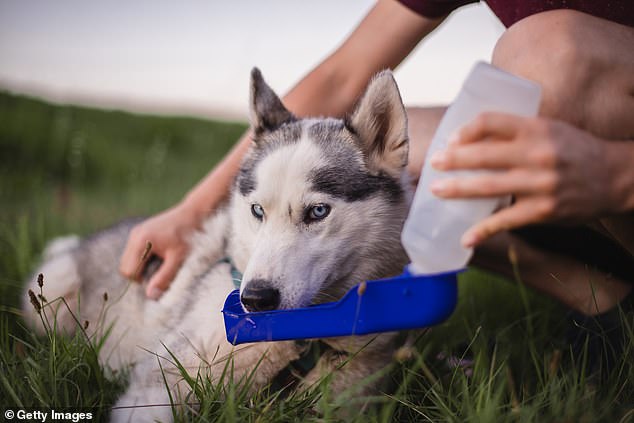Vet warns dog owners about communal water bowls this summer
When you’re walking your dog on a hot summer day, it’s tempting to let him or her drink from communal water bowls provided by well-meaning businesses or neighbors.
But researchers warn that your dog’s water bowl isn’t always shared.
They discovered that these public water sources can be full of diseases such as salmonella, giardia and E. coli that may be present in the public water source.
These bacteria attack your dog’s digestive system, causing vomiting, diarrhea, and loss of appetite. In extreme cases, severe dehydration can lead to death.
Communal water bowls could be full of deadly bacteria and viruses, vet warns
“This is especially concerning if the bowl is not cleaned regularly or if the water is left standing for extended periods of time,” Lori Teller, a clinical professor at the Texas A&M School of Veterinary Medicine and Biomedical Sciences, said in a statement.
‘Stagging water can hold environmental pollutants such as plant matter, parasites, toxins, fungi and more. Dogs who have stepped in feces and then played in the litter box can leave parasites and bacteria in the water.’
In addition to nasty gastrointestinal diseases, communal water bowls can also contain bacteria that cause kennel cough, canine papilloma and leptospirosis.
Kennel cough is a highly contagious respiratory infection that causes coughing, sneezing, runny nose, lethargy, loss of appetite, and a mild fever.
The canine papillomavirus, also known as the wart virus, causes small, benign tumors or “papillomas” in or around a dog’s mouth.
In most cases there are no other symptoms.
But if they are severe, papillomas can cause discomfort or breathing problems.
Leptospirosis is a deadly bacterial infection that thrives in water.
Dogs usually become infected after coming into contact with the urine of infected animals.
Symptoms include fever, vomiting, abdominal pain, diarrhea, refusal to eat, severe weakness and depression, stiffness or severe muscle pain.
In 10 to 20 percent of dogs, this infection is fatal.
The best way to protect your dog from these diseases is to keep shared water breaks to a minimum, Teller advises.
Outside the home, “ideally, owners would carry a collapsible, portable food bowl and some fresh water to give to their dog,” Teller said.
‘An alternative is to go to a restaurant or supermarket and ask for a cup of water for their dog.’
However, there are situations when it is worth letting your pet drink from a communal water bowl.
“If your dog is hot and thirsty and at risk of dehydration, this may be a better option than leaving water in the bowl,” Teller says.

The best way to protect your dog from waterborne diseases is to carry a portable bowl and fresh water with you whenever you leave the house.
But it’s not just the communal water bowls in parks and on sidewalks that can affect your dog’s health.
If you have multiple pets, you should also consider the risks of allowing them to share food and water bowls at home, Teller says.
“In most cases, dogs living in the same household are exposed to the same infectious agents, so sharing a water bowl isn’t going to have a huge impact on that,” Teller said.
However, ‘it is still important that water bowls (and food bowls) are cleaned regularly with soap and hot water.’
Additionally, your dog’s sharing of food and water bowls can affect his eating habits.
“Dogs often require different portions of food, and in many cases, one dog’s diet needs to be adjusted due to a medical condition. That can be a lot more difficult if the dogs share the same food bowl,” Teller said.
‘Or it can happen that one dog prevents another dog from eating from the food bowl.’
Ultimately, it’s up to the owners to decide whether a communal water bowl is safe for their puppy, Teller said.
Always check first that there are no contaminants in the water, such as leaves, droppings, vermin or other things that float in it or make the water cloudy.
Teller emphasizes that if it looks like pond water, your dog should not drink it.
And when in doubt, it’s better to be safe than sorry than to risk the health of your beloved pet.
